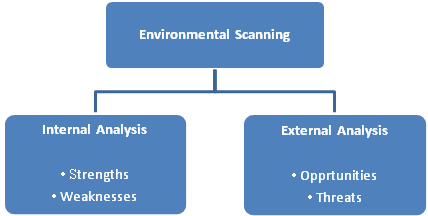SWOT Analysis - Definition, Advantages and Limitations
SWOT is an acronym for Strengths, Weaknesses, Opportunities and Threats. By definition, Strengths (S) and Weaknesses (W) are considered to be internal factors over which you have some measure of control. Also, by definition, Opportunities (O) and Threats (T) are considered to be external factors over which you have essentially no control.
SWOT Analysis is the most renowned tool for audit and analysis of the overall strategic position of the business and its environment. Its key purpose is to identify the strategies that will create a firm specific business model that will best align an organization’s resources and capabilities to the requirements of the environment in which the firm operates.
In other words, it is the foundation for evaluating the internal potential and limitations and the probable/likely opportunities and threats from the external environment. It views all positive and negative factors inside and outside the firm that affect the success. A consistent study of the environment in which the firm operates helps in forecasting/predicting the changing trends and also helps in including them in the decision-making process of the organization.
An overview of the four factors (Strengths, Weaknesses, Opportunities and Threats) is given below-
- Strengths - Strengths are the qualities that enable us to accomplish the organization’s mission. These are the basis on which continued success can be made and continued/sustained.Strengths can be either tangible or intangible. These are what you are well-versed in or what you have expertise in, the traits and qualities your employees possess (individually and as a team) and the distinct features that give your organization its consistency.Strengths are the beneficial aspects of the organization or the capabilities of an organization, which includes human competencies, process capabilities, financial resources, products and services, customer goodwill and brand loyalty. Examples of organizational strengths are huge financial resources, broad product line, no debt, committed employees, etc.
- Weaknesses - Weaknesses are the qualities that prevent us from accomplishing our mission and achieving our full potential. These weaknesses deteriorate influences on the organizational success and growth. Weaknesses are the factors which do not meet the standards we feel they should meet.Weaknesses in an organization may be depreciating machinery, insufficient research and development facilities, narrow product range, poor decision-making, etc. Weaknesses are controllable. They must be minimized and eliminated. For instance - to overcome obsolete machinery, new machinery can be purchased. Other examples of organizational weaknesses are huge debts, high employee turnover, complex decision making process, narrow product range, large wastage of raw materials, etc.
- Opportunities - Opportunities are presented by the environment within which our organization operates. These arise when an organization can take benefit of conditions in its environment to plan and execute strategies that enable it to become more profitable. Organizations can gain competitive advantage by making use of opportunities.Organization should be careful and recognize the opportunities and grasp them whenever they arise. Selecting the targets that will best serve the clients while getting desired results is a difficult task. Opportunities may arise from market, competition, industry/government and technology. Increasing demand for telecommunications accompanied by deregulation is a great opportunity for new firms to enter telecom sector and compete with existing firms for revenue.
- Threats - Threats arise when conditions in external environment jeopardize the reliability and profitability of the organization’s business. They compound the vulnerability when they relate to the weaknesses. Threats are uncontrollable. When a threat comes, the stability and survival can be at stake. Examples of threats are - unrest among employees; ever changing technology; increasing competition leading to excess capacity, price wars and reducing industry profits; etc.
Advantages of SWOT Analysis
SWOT Analysis is instrumental in strategy formulation and selection. It is a strong tool, but it involves a great subjective element. It is best when used as a guide, and not as a prescription. Successful businesses build on their strengths, correct their weakness and protect against internal weaknesses and external threats. They also keep a watch on their overall business environment and recognize and exploit new opportunities faster than its competitors.
SWOT Analysis helps in strategic planning in following manner-
- It is a source of information for strategic planning.
- Builds organization’s strengths.
- Reverse its weaknesses.
- Maximize its response to opportunities.
- Overcome organization’s threats.
- It helps in identifying core competencies of the firm.
- It helps in setting of objectives for strategic planning.
- It helps in knowing past, present and future so that by using past and current data, future plans can be chalked out.
SWOT Analysis provide information that helps in synchronizing the firm’s resources and capabilities with the competitive environment in which the firm operates.

Limitations of SWOT Analysis
SWOT Analysis is not free from its limitations. It may cause organizations to view circumstances as very simple because of which the organizations might overlook certain key strategic contact which may occur. Moreover, categorizing aspects as strengths, weaknesses, opportunities and threats might be very subjective as there is great degree of uncertainty in market. SWOT Analysis does stress upon the significance of these four aspects, but it does not tell how an organization can identify these aspects for itself.
There are certain limitations of SWOT Analysis which are not in control of management. These include-
- Price increase;
- Inputs/raw materials;
- Government legislation;
- Economic environment;
- Searching a new market for the product which is not having overseas market due to import restrictions; etc.
- Insufficient research and development facilities;
- Faulty products due to poor quality control;
- Poor industrial relations;
- Lack of skilled and efficient labour; etc
Hiç yorum yok:
Yorum Gönder